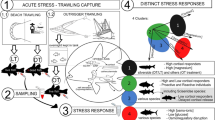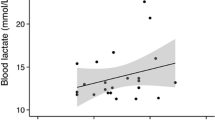Abstract
Elasmobranch stress responses are traditionally measured in the field by either singly or serially sampling an animal after a physiologically stressful event. Although capture and handling techniques are effective at inducing a stress response, differences in protocols could affect the degree of stress experienced by an individual, making meaningful comparisons between the protocols difficult, if not impossible. This study acutely stressed Atlantic sharpnose sharks, Rhizoprionodon terraenovae, by standardized capture (rod and reel) and handling methods and implemented either a single or serial blood sampling protocol to monitor four indicators of the secondary stress response. Single-sampled sharks were hooked and allowed to swim around the boat until retrieved for a blood sample at either 0, 15, 30, 45, or 60 min post-hooking. Serially sampled sharks were retrieved, phlebotomized, released while still hooked, and subsequently resampled at 15, 30, 45, and 60 min intervals post-hooking. Blood was analyzed for hematocrit, and plasma glucose, lactate, and osmolality levels. Although both single and serial sampling protocols resulted in an increase in glucose, no significant difference in glucose level was found between protocols. Serially sampled sharks exhibited cumulatively heightened levels for lactate and osmolality at all time intervals when compared to single-sampled animals at the same time. Maximal concentration differences of 217.5, 9.8, and 41.6 % were reported for lactate, osmolality, and glucose levels, respectively. Hematocrit increased significantly over time for the single sampling protocol but did not change significantly during the serial sampling protocol. The differences in resultant blood chemistry levels between implemented stress protocols and durations are significant and need to be considered when assessing stress in elasmobranchs.


Similar content being viewed by others
References
Barton BA, Iwama GK (1991) Physiological changes in fish from stress in aquaculture with emphasis on the response and effects of corticosteroids. Annu Rev Fish Dis 1:3–26
Barton BA, Weiner GS, Shreck CB (1985) Effect of prior acid exposure on physiological responses of juvenile rainbow trout (Salmo gairdneri) to acute handling stress. Can J Fish Aquat Sci 42:710–717
Black EC (1957) Alterations in the blood level of lactic acid in certain salmonoid fishes following muscular activity. III. Sockeye salmon, Oncorhynchus nerka. J Fish Res Bd Can 14:807–814
Bone Q (1988) Muscles and locomotion. In: Shuttleworth TJ (ed) Physiology of elasmobranch fishes. Springer, Berlin, pp 99–141
Brett JR, Groves TDD (1979) Physiological energetics. In: Hoar WS, Randall DJ, Brett JR (eds) Fish physiology, vol 8. Bioenergetics and growth. Academic Press, New York, pp 279–352
Brill R, Bushnell P, Schroff S, Seifert R, Galvin M (2008) Effects of anaerobic exercise accompanying catch-and-release fishing on blood-oxygen affinity of the sandbar shark (Carcharhinus plumbeus, Nardo). J Exp Mar Biol Ecol 354:132–143
Campbell MD, Patino R, Tolan J, Diamond SL (2010) Sub-lethal effects of catch-and-release fishing: measuring capture stress, fish impairment, and predation risk using a condition index. ICES J Mar Sci 67(3):513–521
Cicia AM, Schlenker LS, Sulikowski JA, Mandelman JW (2012) Seasonal variations in the physiological stress response to discrete bouts of aerial exposure in the little skate, Leucoraja erinacea. Comp Biochem Physiol 162:130–138
Cliff G, Thurman GD (1984) Pathological and physiological effects of stress during capture and transport in the juvenile dusky shark, Carcharhinus obscurus. Comp Biochem Physiol 78A:167–173
Cooper AR, Morris S (1998) The blood respiratory, hematological, acid-base and ionic status of the Port Jackson shark, Heterodontus portusjacksoni, during recovery from anaesthesia and surgery: a comparison with sampling by direct caudal puncture. Comp Biochem Physiol 119A:895–903
Davis M (2002) Key principles for understanding fish bycatch discard mortality. Can J Fish Aquat Sci 59:1834–1843
deRoos R, deRoos CC (1978) Elevation of plasma glucose by catecholamines in elasmobranch fish. Gen Comp Endocrinol 34:447–452
Frick LH, Reina RD, Walker TI (2009) The physiological response of Port Jackson sharks and Australian swellsharks to sedation, gill-net capture, and repeated sampling in captivity. N Am J Fish Manage 29:127–139
Frick LH, Reina RD, Walker TI (2010) Stress related physiological changes and post-release survival of Port Jackson sharks (Heterodontus portusjacksoni) and gummy sharks (Mustelus antarcticus) following gill-net and longline capture in captivity. J Exp Mar Biol Ecol 385:29–37
Hight BV, Holts D, Graham JB, Kennedy BP, Taylor V, Sepulveda CA, Bernal D, Ramon D, Rasmussen R, Lai NC (2007) Plasma catecholamine levels as indicators of the post-release survivorship of juvenile pelagic sharks caught on experimental drift longlines in the Southern California Bight. Mar Freshw Res 58:145–151
Hoffmayer ER, Parsons GR (2001) The physiological response to capture and handling stress in the Atlantic sharpnose shark, Rhizoprionodon terraenovae: description of the secondary stress response. Fish Physiol Biochem 25:277–285
Hoffmayer ER, Hendon JM, Parsons GR (2012) Seasonal modulation in the secondary stress response of a carcharhinid shark, Rhizoprionodon terraenovae. Comp Biochem Physiol 167:81–87
Järvi T (1989) Synergistic effect on mortality in Atlantic salmon, Salmo salar, smolt caused by osmotic stress and presence of predators. Environ Biol Fish 26:149–152
Mandelman JW, Farrington MA (2007) The physiological status and mortality associated with otter trawl capture, transport, and captivity of an exploited elasmobranch Squalus acanthias. ICES J Mar Sci 64:122–130
Mandelman JW, Skomal GB (2009) Differential sensitivity to capture stress assessed by blood acid-base status in five carcharhinid sharks. J Comp Physiol 179:267–277
Manire C, Hueter R, Hull E, Spieler R (2001) Serological changes associated with gill-net capture and restraint in three species of sharks. Trans Am Fish Soc 130:1038–1048
Maule AG, Schreck CB, Bradford CS, Barton BA (1988) Physiological effects of collecting and transporting emigrating juvenile Chinook salmon past dams on the Columbia River. Trans Am Fish Soc 117:245–261
Mugnier C, Fostier A, Guezou S, Gaignon J, Quemener L (1998) Effect of some repetitive factors on turbot stress response. Aquacult Int 6:33–45
Pankhurst NW, Van Der Kraak G (1997) Effects of stress on reproduction and growth in fish. In: Iwama GK, Pickering AD, Sumpter JP, Schreck CB (eds) Fish stress and health in aquaculture. Society for experimental biology seminar series 62, Cambridge, UK, pp 73–93
Parsons GR, Hoffmayer ER (2005) Factors affecting the abundance and availability of the Atlantic sharpnose shark, Rhizoprionodon terraenovae, in the northern Gulf of Mexico. Copeia 2005:914–920
Parsons GR, Hoffmayer ER (2007) Identification and characterization of shark nursery grounds along the Mississippi and Alabama Gulf coasts. In: McCandless CT, Kohler NE, Pratt HL (eds) Shark nursery grounds of the U.S. Atlantic and Gulf of Mexico. American Fisheries Society Publication 50, Bethesda, MD, pp 301–316
Piiper J, Meyer M, Drees F (1972) Hydrogen ion balance in the elasmobranch, Scyliorhinus stellaris, after exhausting activity. Resp Physiol 16:290–303
Rasmussen LEL, Gruber S (1990) Serum levels of circulating steroid hormones in free-ranging carcharhinoid sharks. NOAA Tech Rep 90:143–155
Sharpe CS, Thompson DA, Blankenship HL, Schreck CB (1998) Effects of routine handling and tagging procedures on physiological stress responses in juvenile chinook salmon. Prog Fish Cult 60:81–87
Sulikowski JA, Treberg JR, Howell WH (2003) Fluid regulation and physiological adjustments in the winter skate, Leucoraja ocellata, following exposure to reduced environmental salinities. Environ Biol Fish 66:339–348
Waring CP, Poxton MG, Stagg RM (1997) The physiological response of the turbot to multiple net confinements. Aquacult Int 5:1–12
Wells RMG, McIntyre RH, Morgan AK, Davie PS (1986) Physiological stress responses in big gamefish after capture: observations on plasma chemistry and blood factors. Comp Biochem Physiol 84A:565–571
Wendelaar Bonga SE (1997) The stress response in fish. Physiol Rev 77:591–625
Wingfield JC (1994) Modulation of the adrenocortical response to stress in birds. In: Dave KG, Peter RE, Tobe SS (eds) Perspectives in comparative endocrinology. National Research Council of Canada, Ottawa, pp 520–528
Wingfield JC, Vleck CM, Moore MC (1992) Seasonal changes of the adrenocortical response to stress in birds of the Sonoran Desert. J Exp Zool 264:1–10
Wise G, Mulvey JM, Renshaw GMC (1998) Hypoxia tolerance in the epaulette shark (Hemiscyllium ocellatum). J Exp Zool 281:1–5
Wood CM (1991) Acid-base and ion balance, metabolism, and their interactions, after exhaustive exercise in fish. J Exp Biol 160:285–308
Zar JH (1999) Biostatistical analysis, 4th edn. Prentice Hall, Upper Saddle River, NJ
Acknowledgments
Financial support for this project was partially provided by the National Marine Fisheries Service (MARFIN # NA77FF0548) to G. Parsons. Sampling protocols were approved by the University of Mississippi’s Institutional Animal Care and Use Committee (# 99–006). This project would not have been possible without the help of many volunteers. We would like to thank J. Bartlett, J. Horton, K. Larsen, G. Gray, R. Hoffmayer, A. Lee, D. Drury, R. McCall, G. Zapfe, and W. Dempster for their assistance in the field. We also thank M.S. Peterson, J.S. Franks, and G. Pellegrin for their critical review and advice on this manuscript.
Author information
Authors and Affiliations
Corresponding author
Rights and permissions
About this article
Cite this article
Hoffmayer, E.R., Hendon, J.M., Parsons, G.R. et al. A comparison of single and multiple stressor protocols to assess acute stress in a coastal shark species, Rhizoprionodon terraenovae . Fish Physiol Biochem 41, 1253–1260 (2015). https://doi.org/10.1007/s10695-015-0083-4
Received:
Accepted:
Published:
Issue Date:
DOI: https://doi.org/10.1007/s10695-015-0083-4




